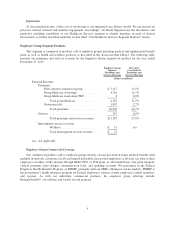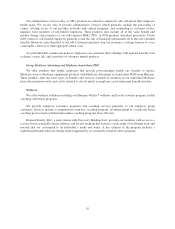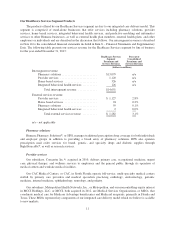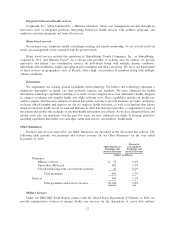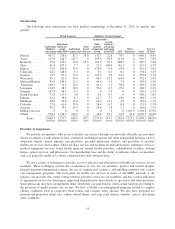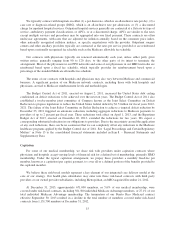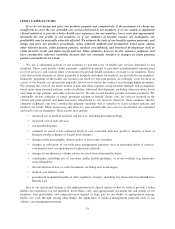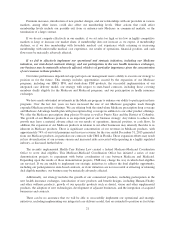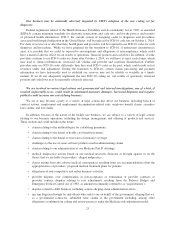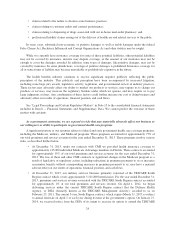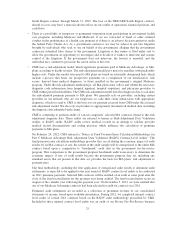Humana 2013 Annual Report Download - page 27
Download and view the complete annual report
Please find page 27 of the 2013 Humana annual report below. You can navigate through the pages in the report by either clicking on the pages listed below, or by using the keyword search tool below to find specific information within the annual report.and individual commercial health insurance and specialty products through licensed independent brokers and
agents. For our Medicare products, commissions paid to employed sales representatives and independent brokers
and agents are based on a per unit commission structure, regulated in structure and amount by CMS. For our
individual commercial health insurance and specialty products, we generally pay brokers a commission based on
premiums, with commissions varying by market and premium volume. In addition to a commission based
directly on premium volume for sales to particular customers, we also have programs that pay brokers and agents
based on other metrics. These include commission bonuses based on sales that attain certain levels or involve
particular products. We also pay additional commissions based on aggregate volumes of sales involving multiple
customers.
In our Employer Group segment, individuals may become members of our commercial HMOs and PPOs
through their employers or other groups, which typically offer employees or members a selection of health
insurance products, pay for all or part of the premiums, and make payroll deductions for any premiums payable
by the employees. We attempt to become an employer’s or group’s exclusive source of health insurance benefits
by offering a variety of HMO, PPO, and specialty products that provide cost-effective quality health care
coverage consistent with the needs and expectations of their employees or members. In addition, we have begun
to offer plans to employer groups through private exchanges. Employers can give their employees a set amount
of money and then direct them to a private exchange. There, employees can shop for a health plan and other
benefits based on what the employer has selected as options. We also sell group Medicare Advantage products
through large employers. We use licensed independent brokers, independent agents, and employees to sell our
group products. Many of our larger employer group customers are represented by insurance brokers and
consultants who assist these groups in the design and purchase of health care products. We pay brokers and
agents using the same commission structure described above for our individual commercial health insurance and
specialty products.
Underwriting
Beginning in 2014, the Health Care Reform Law requires all individual and group health plans to guarantee
issuance and renew coverage without pre-existing condition exclusions or health-status rating adjustments.
Accordingly, newly issued individual and group health plans are not subject to underwriting in 2014 and beyond.
Further, underwriting techniques are not employed in connection with our Medicare, military services, or
Medicaid products because government regulations require us to accept all eligible applicants regardless of their
health or prior medical history.
Prior to 2014, through the use of internally developed underwriting criteria, we determined the risk we were
willing to assume and the amount of premium to charge for our commercial products. In most instances,
employer and other groups had to meet our underwriting standards in order to qualify to contract with us for
coverage.
Competition
The health benefits industry is highly competitive. Our competitors vary by local market and include other
managed care companies, national insurance companies, and other HMOs and PPOs, including HMOs and PPOs
owned by Blue Cross/Blue Shield plans. Many of our competitors have larger memberships and/or greater
financial resources than our health plans in the markets in which we compete. Our ability to sell our products and
to retain customers may be influenced by such factors as those described in the section entitled “Risk Factors” in
this 2013 Form 10-K.
Government Regulation
Diverse legislative and regulatory initiatives at both the federal and state levels continue to affect aspects of
the nation’s health care system.
17




